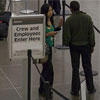
Letter to the Editor Referencing Airport Security
- By Ginger Hill
- Aug 30, 2013
 Here at Security Products magazine and Security Today, we love hearing from our readers! Our Editor in Chief, Ralph Jensen, recently received an email from Greg Raiff CEO of Private Jet Services, a corporate aviation consultancy providing mission-critical flight services to a global clientele of corporations, professional and collegiate athletic teams, live entertainment tours, government and others.
Here at Security Products magazine and Security Today, we love hearing from our readers! Our Editor in Chief, Ralph Jensen, recently received an email from Greg Raiff CEO of Private Jet Services, a corporate aviation consultancy providing mission-critical flight services to a global clientele of corporations, professional and collegiate athletic teams, live entertainment tours, government and others.
We feel that the content of this email provides some great insight about airport security.
“To the Editor:
Airport security has gone through a lot of changes since the terrorist attacks on 9/11. We have to remove our shoes, our belts and our jackets. We stand in long security lines waiting to go through full body scanners, and if we haven’t experienced one personally, we’ve all heard jokes about the full-body pat down.
To increase security after the Christmas 2009 ‘underwear bomber,’ airports began installing backscatter scanners. These machines freaked people out not only because they produced eerie views of passengers beneath their clothes, but because they use X-rays, which caused some concern about possible cancer risks.
Late last year, the TSA began quietly removing these machines from the country’s largest airports, including Boston’s Logan Airport. They’ve been replaced with millimeter-wave scanners that use radio waves similar to cell phones to detect irregularities and show TSA workers a cartoon outline of a passenger, putting privacy concerns at ease. But 91 backscatter scanners, which cost Americans about $14 million, are now sitting in a warehouse and the lines to get through security are still as long as ever.
With airport security in such disarray, I wonder why the TSA couldn’t expand its Trusted Traveler program? Trusted Traveler lets low-risk travelers pre-register with U.S. Customs, including a fingerprint scan, which can then be used to expedite airport security while traveling in and out of the country. The TSA started a pilot program last year, called PreCheck, which allows passengers who submit to pre-approval to go through expedited lines, keep their shoes on, as well as keep their laptops and liquids in their bags. There is also a private company running a domestic version of this program called CLEAR, but it is currently only available in a handful of airports.
These programs are clearly in their early stages, but they have potential to make airline travel a little easier. Maybe instead of spending millions of dollars every few years on new machinery, the TSA could invest the same resources into a speedier security system that puts less pressure on the passenger and provides security with good results? If the TSA decides it wants to offer all Americans the chance to register for quicker security lines at the airport, I am certain thousands of people would line up for the chance. It seems that would be the better investment.”
Hey readers! We’d love to hear your feedback, thoughts and opinions.
About the Author
Ginger Hill is Group Social Media Manager.